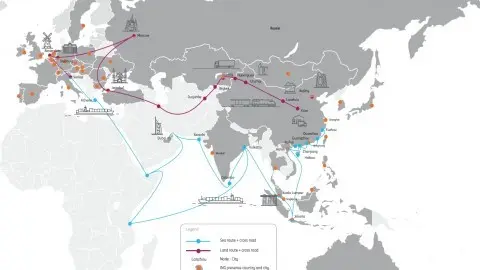China’s Belt and Road: Bigger than the Marshall Plan?
The scale of the Belt and Road initiative could have profound economic implications. In the beginning, developing countries will welcome the infrastructure investment while China will extend its soft power. But around 10-20 years later, we expect the negative impacts on growth and debt to become apparent
A primer
China’s Belt and Road Initiative is set to transform a large part of the world. First proposed by Chinese President Xi Jinping in 2013, this long-term project is among the most ambitious ever conceived. It involves 65 countries (representing 60% of the world’s population and 30% of global GDP), including not just China’s nearest neighbours but also countries in South Asia, the Middle East, Africa and Central and Eastern Europe.
BRI land corridors are known as the 'belt' and include the development of overland roads, bridges, tunnels, rail routes, oil and natural gas pipelines, and other infrastructure projects. Belt corridors will connect China with Europe via Central Asia and Russia; the Persian Gulf and the Mediterranean Sea via Central and Western Asia; and Southeast Asia, South Asia and the Indian Ocean. Sea-based corridors are described as part of the 'road' and include the development of ports. The road extends from China’s coastal ports to the South China Sea, Indian Ocean, Africa and Europe and to the South Pacific Ocean.
China's Belt and Road Initiative
China’s Belt and Road Initiative should promote economic and political integration with countries associated with the projects. Money certainly helps - with deeper economic integration there should be money-making opportunities. The Chinese government has gained status regionally and internationally, as it continues to lead the BRI.
We see the initiative as more than a Marshall Plan 2.0. Its objective is not stability after a war but rather to speed the economic growth cycle in the Eurasia and Asia-Pacific regions. This has encouraged smaller countries to get involved in the programme when the BRI was launched.
The Belt and Road plan is in China's constitution
BRI is more a geopolitical powerbank for China
The plan will benefit the inner part of China, and bring wealth to companies and individuals along the Belt and Road at its early stage. Eventually, when the BRI is almost accomplished, it could become China's international political powerbank.
Economies benefit from growth at the early stage of BRI
In theory, one way to help Belt and Road economies grow is to equip them with infrastructure. Investment here should boost economic activity, particularly for those countries with poor infrastructure. Transportation and energy grid infrastructure, in theory, is essential to boost economic activity, leading to more manufacturing activity, trade flows, jobs, higher salaries and consumption. In other words, economies with better infrastructure should grow at a faster pace and enjoy a longer growth cycle.
Between 2013, when the BRI was first mooted, and 2016, most investment from China was in the area of transportation.
Investment so far
Landmark projects
BRI is a multi-decade plan that has already delivered a number of significant projects that will facilitate long-term economic growth. These include:
- In June 2017, the $3.2 billion 470km Nairobi to Mombasa railway opened. It will extend to Uganda, Rwanda, South Sudan and Ethiopia, placing Kenya at the centre of an East African rail network.
- In December 2017, Russia launched the first phase of the $27 billion Yamal liquefied natural gas (LNG) plant in Siberia, with support from China’s China National Petroleum Corporation (CNPC). The next phases are due to come in 2018 and 2019. The project will lower energy costs for countries taking part in the BRI while providing valuable new export markets for Russia.
- Chinese banks are helping to finance the $3.4 billion 2.4 gigawatt Hassyan clean coal-fired power station plant in Dubai as part of the BRI. All projects undertaken have to meet environmental and social standards and safeguards. As a result, investment in power generation, for example, will be focused on renewables, LNG and clean coal.
But they are building up debts from BRI projects
But the theory is valid only if the infrastructure projects are in need, and money spent on project financing are used efficiently. We are concerned that money borrowed to build some infrastructure projects would yield low returns that limits BRI economies' repayment ability.
It is well known that an element of funding for BRI investment projects has come from China and funds participating in China. But it is less well known that most of the lending facilities have come from the China Development Bank and a group of Chinese banks.
The first well-known source of funds for the BRI is the Silk Road Fund. The Chinese government will make an estimated $40 billion of equity investments through its Silk Road Fund and is eager to earn a return on its investments. As of August 2017, the committed investment in the Silk Road Fund was $680 million, with equity investment accounting for nearly 80%.
The Asian Infrastructure Investment Bank (AIIB) will also be a major investor. While it was originally proposed by China, the bank has 56 member states and is renowned for its robust corporate governance. The creditworthiness of its investments will be thoroughly scrutinised. Such tight credit screening explains why the AIIB has only announced financing amounting to $3.7 billion for the BRI thus far.
Apart from the Silk Road Fund and AIIB, the China Development Bank had lent out $110 billion in loans to Belt and Road projects as of January 2018. On top of that, the China Development Bank and China Export Import Bank announced separate BRI funds, worth $36.2 billion and 18.8 billion, respectively, at the 2017 Belt and Road Summit.
China is the key lender
With so many funds preparing to support the BRI, we want to know the main lender to BRI projects because this could reveal the risk-bearing entity and the likely reaction if things were to go wrong.
The Ministry of Commerce of China provided a breakdown on the money flow from China to Belt and Road countries.
- Investment: Chinese corporates' direct investment was $14.36 billion in 2017 to countries along the Belt and Road, down 1.2% from 2016. Belt and Road accounted for only 12% of outward investment in 2017. Most of the money was invested in Singapore, Malaysia, Laos, Indonesia, Pakistan, Vietnam, Russia, United Emirate States and Cambodia.
- M&A activities amounted to $8.8 billion in 2017, up 32.5% from 2016. This includes the $2.8 billion acquisition of 12% stakes in Abu Dhabi United Arab Emirates oil company by China National Petroleum Corporation and China Watson Investment.
- New contracted projects amounted to $144.3 billion, with 54.4% of all new foreign contracted projects made by China, up from 14.5% in 2016.
According to the above breakdown, China's direct investments along Belt and Road economies have been small, only around one-tenth of the project values created by the BRI. Thus, project financing uses most of the lending facilities.
This is also reflected in terms of commercial bank credit provided to BRI projects. According to the Chinese government, between 2015 and 2017, Chinese-owned financial institutions participated in 2,700 BRI projects, lent out $200 billion, with a further $200 billion credit facilities to be drawn.
From this data, we see that BRI activities are funded principally by the China Development Bank and a group of Mainland Chinese financial institutions. The Silk Road Fund (which is partially backed by the China Development Bank) and AIIB have been more cautious in providing credit to BRI projects.
China's financial involvement in Belt and Road projects US$bn
Could BRI be a debt trap? The question that we want to answer
Because China is the main creditor for BRI projects, there is growing concern that countries that are part of the plan could incur significant debt to the Chinese government and Chinese enterprises. If unable to service that debt, China’s leverage over these countries will increase further, both economically and politically.
This has hit a nerve at the IMF.
On 21 May 2018, an IMF report pointed out that Montenegro, although having a relatively strong economy, has growing debt pressure. In early 2018, IMF managing director Christine Lagarde warned that the Belt and Road should "travel only where it is needed".
China appears to be becoming increasingly careful when it invests in the BRI. Restrictions on investments flowing into the real estate sector in Belt and Road economies have been in place since early 2017, and its restricted cross-border insurance policies at the beginning of 2018.
We agree that the process of building infrastructure could result in higher debt loads if the projects don't operate efficiently. Though some Chinese enterprises seek profit from their investments, some projects may not generate enough cash flows when the projects are completed. This would create debt problem of BRI economies.
And as the key lender, China could impose conditions when it comes to write-off of debts. These conditions could materialise in economic and political benefits for China, and could strengthen China's geopolitical power along the Belt and Road. But this may happen near the final stage of completing the BRI, which we believe 10-20 years from now.
From now to 10-20 years later, China does not want to build up a reputation as a political lead of Belt and Road countries at this early stage of pushing the BRI. Chinese lenders would either extend more loans or roll it over at lower interest rates when some projects would not pay off.
This publication has been prepared by ING solely for information purposes irrespective of a particular user's means, financial situation or investment objectives. The information does not constitute investment recommendation, and nor is it investment, legal or tax advice or an offer or solicitation to purchase or sell any financial instrument. Read more
Download
Download article
6 June 2018
China’s Belt and Road Initiative This bundle contains 2 Articles